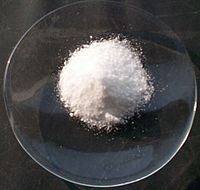
Photo from wikipedia
A chemical contaminant of growing concern to freshwater aquatic organisms, including many amphibians, is chloride ion. The salinization of freshwater ecosystems is likely caused, in part, by the application of… Click to show full abstract
A chemical contaminant of growing concern to freshwater aquatic organisms, including many amphibians, is chloride ion. The salinization of freshwater ecosystems is likely caused, in part, by the application of massive amounts of road de-icing salts to roadways during winter months. The issue of freshwater salinization has become the subject of many toxicity studies and is often investigated in conjunction with other chemical stressors. However, few published studies attempt to investigate the interactions of elevated chloride concentration and increased temperature. Further, no studies have investigated the gap between the recommended feeding conditions typically used in standard toxicity tests and those that may exist in natural amphibian habitats. This study addressed the critical issues of elevated chloride, increased temperature, and variation in food quality. We conducted a 96-h acute toxicity test to investigate acute chloride toxicity as impacted by different diets, as well as a chronic toxicity test to investigate the impacts of chloride, temperature, and resource quality on the survival and development of larval Lithobates sylvaticus (wood frogs). Chloride LC50s ± 1 SE were 3769.22 ± 589.05, 2133.00 ± 185.95, and 2644.69 ± 209.73 mg Cl-/L were for non-fed, low-protein diet, and high-protein diet, respectively. For the chronic toxicity study, elevated chloride decreased tadpole survival. Increased temperature, and lower resource quality, were found negatively impacted survival of tadpoles and altered time-to-metamorphosis. This study shows that environmentally relevant concentrations of chloride, temperatures, and the protein content of the diet all exert critical effects on larval wood frogs.
Journal Title: Environmental pollution
Year Published: 2020
Link to full text (if available)
Share on Social Media: Sign Up to like & get
recommendations!